- Home
- Michael Newton
The Texarkana Moonlight Murders: The Unsolved Case of the 1946 Phantom Killer Page 18
The Texarkana Moonlight Murders: The Unsolved Case of the 1946 Phantom Killer Read online
Page 18
It is known that the latent impressions in this case have been compared with fingerprints of [¼ line deleted] with negative results, however, in view of the above information, it is requested that these latents be compared with the fingerprints of these two persons and that the Little Rock and Dallas Divisions be advised as to the results of the examination.57
That comparison, completed on October 18, absolved both suspects.58
On October 15, 1948, Little Rock sent another request to headquarters, this one headed with the now-missing name of a “VICTIM WHITE SLAVE TRAFFIC ACT.”59 The memo read:
It is requested that test shots be fired from the enclosed gun. That the bullets be compared with the unidentified ammunition file. It is also requested that the serial [deleted] be searched through the National Stolen Property File. This gun was recovered by [name deleted] of the Texarkana, Arkansas Police Department. Inasmuch as it is the same caliber of gun used in the Texarkana Murders, he requested it be checked.60
The pistol, dubbed “K2,” was a 7.65mm Walther semiautomatic pistol, and as such, the bureau’s lab determined, could not have fired the Texarkana death slugs. In fact, its barrel rifling revealed six lands and grooves with a right-hand twist, compared to the murder weapon’s left-hand rotation. Neither had the pistol ever been reported stolen.61
* * *
On June 1, 1948, twenty-three-year-old Virginia Carpenter left her Texarkana home and rode the train to Denton, Texas, where she was enrolled at the Texas State College for Women (now Texas Woman’s University). She caught a cab from the train depot, its driver reporting that he delivered Carpenter to the curb outside Brackenridge Hall shortly after 9:00 P.M. In parting, Carpenter gave the driver an extra dollar and a claim check for her trunk, still at the railroad station, asking him to retrieve and deliver it the next morning. Before driving off, the cabbie later said, he saw Carpenter approach two young men she appeared to know, saying, “Well, hi. What are you doing here?”62
The driver dutifully returned with Carpenter’s trunk, as agreed, and left it on the porch of Brackenridge Hall. There it sat for days, until college staffers grew suspicious and contacted local police. News of a missing Texarkana co-ed raised fresh fears of the Phantom, exacerbated by the fact that she had personally known three of the teenagers murdered in 1946, but investigators followed other paths, grilling Carpenter’s boyfriend a dozen times—once for twelve hours straight—and subjecting him to a polygraph test, which he reportedly passed.63
Next, they turned to the cabbie, identified in police files as a forty-five-year old “bootlegger, part-time mechanic and automobile trader” from Midland, Texas, with a record of assaultive behavior. He, too, sat through multiple interrogations, plus a body search that found no recent injuries, insisting that he had reached home on June 1 around 10:00 P.M. His wife confirmed that alibi—then changed her tune in 1957, claiming that he had in fact returned between 2:00 and 3:00 A.M. on June 2. She added, in that statement, that on each June 1 thereafter, when the Denton Record-Chronicle rehashed the unsolved case, he made a special point of driving to Denton and buying the paper. Though never charged, he remained on file as a suspect until his death.64
In May of 1998, an unnamed man in his seventies told authorities that he knew who had killed Virginia Carpenter, and could show them where her body was buried. The field trip proved fruitless, though police admitted that their informant “was close to some of the people who were allegedly involved in Ms. Carpenter’s disappearance.” By that time, however, Denton County’s sheriff declared that the two leading suspects were dead. The case remains officially unsolved.65
* * *
On November 5, 1948, H. B. “Doodie” Tennison swallowed a lethal dose of poison at a residence near the University of Arkansas at Fayetteville, where he was enrolled as an eighteen-year-old freshman. He left behind three notes—none ever published in full—for whoever might find his body. The first, found on a dresser in the bedroom where he died, was a poem/riddle titled “My Final Word.” It offered cryptic clues to opening a strongbox recovered from Tennison’s room, keyless, wherein lay the solution to his suicide. Police ignored the rhyme and cracked the box by force.66
The second note began: “This is my last word to you fine people. Why did I take my own life? You may be asking that question. Well, when you committed two double murders you would, too.” In fact, while the full note was kept under wraps, various newspaper accounts make clear that Tennison confessed to all the Phantom’s shootings, including the Starks attack.67
The third typewritten note, found a short time later by Sheriff Bruce Crider of Washington County, contradicted the second. It read: “Please disregard all other messages which I have written, they are only thoughts which I was thinking about as possible reasons for taking my life. As I think about it, it is none of these things. They are not the reason for this incident, there’s a much better point to it all. Happiness. Yes, happiness. If I am out of the way, all the family can get down to their lives.”68
Tennison’s family, described as wealthy, made no public comment on his passing. Police discovered that Tennison was in Texarkana on May 3, 1946, but a sixteen-year-old friend recalled spending the evening with him, insisting that “Doodie” was never out of his presence from 7:00 P.M. until midnight, when news of the Starks shooting spread through town. Subsequent investigation proved that Tennison’s fingerprints matched none of the latents collected from Phantom crime scenes.69
To be on the safe side, Sheriff Presley sent Tennison’s fingerprints to FBI headquarters, for comparison with the killer’s latent prints. The bureau’s lab excluded Doodie as a suspect on November 9.70
* * *
One week to the day after Tennison’s posthumous exoneration, on November 15, Max Tackett replaced Henry Grady Holmes as chief of police in Texarkana, Arkansas.71 His promotion did not please the FBI, as noted in a memo dated four days later. It read:
SAC Dean Morley, while in Washington a few days ago, advised the Bureau that the new Chief of Police at Texarkana, Arkansas, Mack Hackett (Tackett?) is very anti–Bureau. He has made open attacks definitely proving his hostility.
The Agents from the Identification Division who are going to Texarkana, Texas to work with the Sheriff comparing latent fingerprints of the four law enforcement agencies should be instructed to avoid any contact with the new Chief of Police at Texarkana, Arkansas. They should he instructed to contact the Resident Agent at Texarkana immediately on arriving in order that they may be fully informed so that no difficulty will be encountered.72
In fact, Bill Presley had contacted local agents and the Little Rock field office on November 13, requesting assignment of a bureau fingerprint expert to Texarkana, stating his belief that “the only remaining possibility of an immediate solution in the case is through the identification of the subject through the unidentified latent fingerprints.”73 To that end, ten bureau leaders conferred on November 18 and unanimously approved Presley’s request, sending not one, but two print experts for a two-week marathon examination of fingerprint cards. The minutes of that meeting closed with a handwritten note from Hoover: “It should be remembered that Max Tackett who is very unfriendly has been appointed Chief of Police at Texarkana, Ark. We should not cooperate with him under any circ[umstance]s.”74
The bureau, in short, was prepared to let a killer stay at large, while salving Hoover’s ego.
The visiting G-men announced completion of their survey in Texas—5,184 fingerprint cards in all—on December 3, 1948.75 Much remained to be done, however, as the Arkansas State Police had another 800 cards, while Chief Tackett’s department held 11,700. Despite Hoover’s previous order, the technicians forged ahead in Arkansas and found Tackett cooperative. All in vain, though, since the epic project failed to match the Phantom’s latent prints.76
Whatever his opinion of the FBI, Chief Tackett did not behave like a man who believed he had captured Texarkana’s Phantom in July 1946. Between December 1948 and F
ebruary 1960, he submitted at least 199 requests for comparison of various suspects’ fingerprints with the Phantom latents on file in Washington. The vast majority of those requests—161—involved multiple suspects, though censorship of bureau files renders precise tabulation impossible. (One memo notes that Tackett “requested fingerprints of numerous suspects be compared with the unidentified latents” on file.) There may be even more requests from Tackett, but deletion of the sender’s name in several cases obscures their source.77
None of the fingerprints examined matched the killer’s, but the epic exercise confirms that Youell Swinney’s prints, likewise, failed to support the allegations of his guilt.
* * *
On January 10, 1949, Fred Hickman, chief of security for the Agricultural and Mechanical College of Texas (now Texas A&M University), mailed a letter to Captain Gonzaullas in Dallas. It read:
Dear Capt.:
An acquaintance of mine gave me information that he thinks will lead to the solution of the killings, etc. in Texarkana, Texas some time ago. This informer has given me information in the past that has worked out well. I am passing this on to you for any help that it may be in your efforts to find a solution to the case. The information will be easily checked in Temple, Texas and in Texarkana, Texas.
Suspect: Eddie Vesterban about 42 years, 5 ft. 10 in. and very dark lives in Temple, Texas. His intelligence is below normal. He lives with his mother. He has never held a job other than something like running an errand. He has a married sister, name not known to my informer, who lives with her husband in Texarkana, Texas or in the country near Texarkana. He was alleged to have visited his sister about the time the killings, etc. took place in Texarkana. He is alleged to have been there two or three months. His mother is supposed to have been very worried about him while he was there. He has a .22 caliber rifle that he is alleged to have taken to Texarkana with him.
You are supposed to be able to verify this information by checking with Mrs. Q. C. Martin and her husband, 104 South 23rd, Temple, Texas. They are also supposed to know the name and address of the married sister in Texarkana.
The only history of this party being interested in men and women in parked automobiles is that he was alleged to have been caught by Jesse Winewt, employee of Santa Fe Railroad and another person while he was slipping up on a couple parked near a lake near Temple, Texas. He is also alleged to have accosted a woman school teacher on a country road and asked her if she was putting out.
I hope the above information is of some value to you. I believe it is worth checking.78
As with other correspondence from the ranger files, no further information is available on Vesterban. The next confession to the Phantom’s crimes was postmarked from Little Rock on January 13, 1949, addressed to the governor of Texas. It read:
I, Willie E. Blackmon, declare that we have finished the war of Revealation. The originator of the aims was Franklin D. Roosevelt.
I am the Texarkana Killer, but I also killed Satan.
I have challenged J. Edgar Hoover and [President Harry] Truman to a gun Duel. They must meet me immediately.
Respectfully yours,
Willie Blackmon79
DPS Director Homer Garrison sent Blackmon’s note on to Captain Gonzaullas, noting, “This individual is evidently a mental case, however, it might be a good idea for you to have the authorities in Little Rock check on him to see whether or not he could have had any connections with the Texarkana slayings.”80 Whether Gonzaullas followed that advice or not, the ranger files do not reflect.
J. Edgar Hoover received the next curious letter, mailed from Texarkana on February 3, 1949. It read:
Dear Mr. Hoover: I am writing to you to see if I can come to Washington to talk to you about solving the murder of [names deleted] which occurred on April 14th, 1946. I do not feel that the case has been properly handled and I feel sure it can be solved if the right people try diligently to do it. Would you see me there & give me the time to tell all I know about the slaying, this I have gotten myself & from Private Detectives.81
Hoover declined the offer, advising his correspondent—name deleted by FBI censors—that “although I would like to be of service to you, you are advised that the facts related in your letter do not constitute a violation of any Federal statute over which this Bureau has jurisdiction.” Hoover suggested contacting police in Texarkana or the Arkansas attorney general.82
On the same day Hoover sent that letter, February 10, the Dallas field office submitted another list of 102 suspects, requesting comparison of their fingerprints with the Phantom’s. Of those, eighty-five were found in bureau files. None of their prints matched the Texarkana latents.83
* * *
On March 14, 1949, Inez Martin wrote to DPS Director Garrison in Austin. Her letter read:
The attorney general suggests that I write you in behalf of my interest to solve the murder of my little son, not quite seventeen, who was murdered here three years ago April 14th 1946.
I clung to hopes for sometime, that the Rangers and the city police might bring the slayers to admit or surrender, but I have no hopes now of either doing anything. I have a story some hints, that I want to give to some one who would be interested in showing who did the double slaying at the time Paul was murdered. I don’t put any faith in the city police or Rangers. Can you suggest some help?
I can make a trip to Austin if you think you could muster up any interest or courage toward solving this one murder. Let me know something as soon as you can.84
Garrison tried to put the grieving mother’s mind at ease with a reply, on March 18, that read:
This will acknowledge receipt of your communication of March 14 with reference to the murder of your son in Texarkana on April 14, 1946.
You may be assured that this Department, through Captain Gozaullas and the Rangers under his command, have spent many days and travelled thousands of miles in this investigation. We will continue to do so until the culprit is brought to justice. I can assure you that the Texas Rangers is one of the most outstanding law enforcement organizations in the world today and we never quit the investigation of a case until it is finally solved.
If you have any additional information that you believe would be beneficial, I would appreciate it greatly if you would send it to me.85
* * *
On April 1, 1949, the Bowie County Sheriff’s Department sent FBI headquarters a new list of 100 potential Phantom suspects, seeking fingerprint comparisons. Eighty-six were cleared, while fourteen were not found in bureau files.86 Another three-page list of names followed on April 26, with negative results.87
The Dallas field office was busy, too, sending one suspect’s name to Washington on April 7, and a list of seventy-five on May 4. Of that lot, all but one suspect was cleared. The seventy-sixth, a Wilbert S. Dodd, had no fingerprint record on file.88
On May 31, 1949, E. G. Henslee—Bill Presley’s successor as sheriff of Bowie County—sent FBI headquarters a sheet of paper headed “Bedside Notes,” described as “bearing known handwriting specimens of [name deleted.]” Henslee sought a fingerprint comparison, but once again the Texarkana latents did not match.89
One day later, on June 1, Sheriff Henslee sent the bureau a list of eighty-seven potential suspects. Seventy-four were cleared by fingerprints, while thirteen were unknown to the FBI.90 June 30 brought another list of 100 names from Henslee. Eighty-eight were exonerated, while twelve had no prints on file.91
Police Chief Clarence Baker of Hope, Arkansas—twenty-two miles northeast of Texarkana, in Hempstead County—provided the FBI lab with a change of pace in August 1949, when he found a .32-caliber Colt automatic wrapped in a handkerchief, under a Missouri Pacific Railroad bridge at nearby Fulton. Recovered on August 4 and sent through channels to Washington, the pistol was test-fired, but extreme corrosion of its barrel prevented ballistic comparison with the Texarkana murder slugs. The weapon’s serial number was restored, with difficulty, but it matched no guns lis
ted in the bureau’s National Stolen Property Index. At the time, no records were maintained of serial numbers when firearms were sold, so the gun proved untraceable.92
And the deluge of suspects continued. The FBI’s Dallas field office sent another hundred names to Washington on August 16, 1949; ninety-five were cleared by fingerprint comparisons, while five had no records.93 More arrived from Dallas on October 12 and were eliminated.94 Chief Runnels sent a single suspect’s prints to Washington on October 14, and Sheriff Henslee mailed another four-page list on October 21, without a match.95 Dallas sent another hundred names on November 2; ninety-one were absolved, while nine had no records on file.96 Sheriff Henslee sent yet another hundred-name list on December 2; eighty-six were cleared by fingerprints, while fourteen were unknown to bureau filekeepers.97
Officials of the Missouri–Kansas–Texas Railroad furnished FBI agents with an intriguing lead on November 17, 1949. As related in a heavily-censored memo from Dallas to headquarters:
[Name deleted] of Special Services, MK&T Railroad, Dallas, Texas, advises that one [name deleted] was employed by the railroad on [1½ lines deleted] were reportedly unsatisfactory, in that he was found undependable and made various misrepresentations, specifically, holding himself out as a special agent of the railroad on one occasion, and representing himself as a yard master on another occasion, to either police officials or other employees of the railroad. In addition, this individual allegedly informed a cafe owner in Dallas that he was an FBI agent.
According to [½ line deleted] is a person possessed of a dual personality and his actions and attitude are regarded as peculiar. [Name deleted] stated that about January, 1945 [name deleted] purchased a .32 caliber blue steel Colt automatic from [4¼ lines deleted].
According to [½ line deleted] allegedly made frequent trips to Texarkana, Texas-Arkansas while employed by the railroad, and also frequently absented himself from his work with no explanation being given. In view of this fact, together with the known fact that the murders were committed with a .32 caliber Colt automatic or similar gun, and in view of [name deleted] personality, [name deleted] considered [name deleted] a suspect.

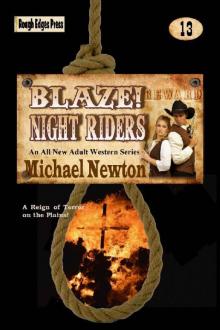 Blaze! Night Riders
Blaze! Night Riders How to Write Action Adventure Novels
How to Write Action Adventure Novels Blaze! Bad Medicine
Blaze! Bad Medicine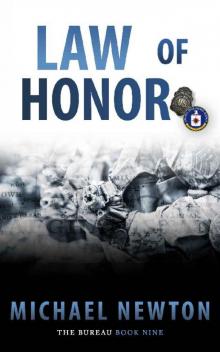 Law of Honor
Law of Honor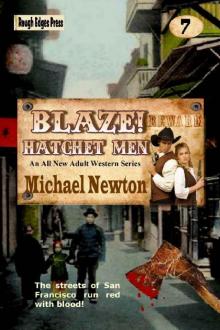 Blaze! Hatchet Men
Blaze! Hatchet Men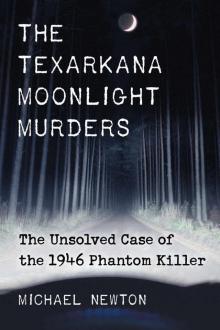 The Texarkana Moonlight Murders
The Texarkana Moonlight Murders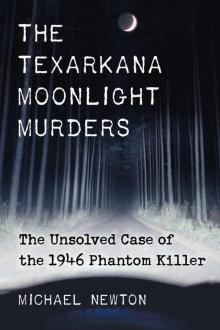 The Texarkana Moonlight Murders: The Unsolved Case of the 1946 Phantom Killer
The Texarkana Moonlight Murders: The Unsolved Case of the 1946 Phantom Killer